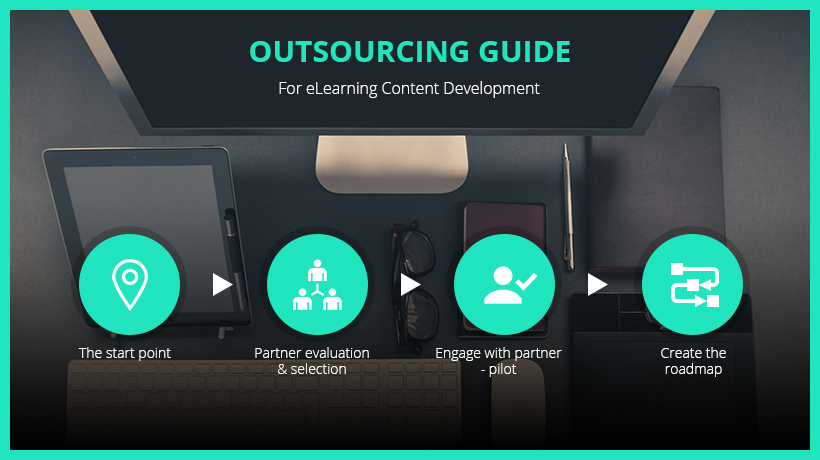
The application of Gamification in corporate training has evolved significantly since its introduction almost a decade ago. From being a buzz, it is an accepted practice that has shown its versatility to be used for most of the corporate training needs.
What Is Gamification in Corporate training?
Gamification in corporate training is a modern strategy that incorporates game design elements in non-game contexts to improve learner engagement and motivation. Gamification in corporate training involves integrating game design elements, such as point scoring, competition, and rules of play, to enhance the learning experience, making it more interactive and enjoyable. The key to successful Gamification is to strike a balance between learning objectives and game mechanics.
- By adding fun to the learning experience, the learners can be engaged better.
- When applied correctly, the Gamification in corporate training will demonstrate a higher value in terms of stickiness of learning, better completion rates, and higher application of learning on the job.
Key Components of Gamification:
-
Points System:
A scoring mechanism that rewards learners for completing tasks, achieving goals or demonstrating desired behaviors.
-
Levels and Progression:
Different stages or levels in training materials that learners progress through, often becoming progressively challenging.
-
Badges and Achievements:
Visual or symbolic rewards given for specific accomplishments, encouraging a sense of accomplishment and recognition.
-
Leaderboards:
Rankings that display the top performers, fostering a sense of competition and community among learners.
-
Challenges and Quests:
Engaging tasks or missions that learners must complete, often incorporating real-life scenarios relevant to their job roles.
-
Feedback and Rewards:
Immediate and ongoing feedback on performance, often linked with rewards, to keep learners motivated and on track.
How Does Gamification for Learning Score over Traditional eLearning?
Most adult learners find motivation in rewards and recognition and both these aspects are intrinsic to the Gamification of learning.
Specifically, the use of Gamification in corporate training surpasses traditional eLearning as it:
- Enhances learner engagement.
- Provides a sense of achievement.
- Influences behavior change.
- Invokes a healthy spirit of competition.
The Benefits of Gamification in Corporate Training
Gamification in corporate training offers substantial benefits, enhancing both the effectiveness and overall learning experience.
-
Increased Learner Engagement:
Gamification makes training more interactive and enjoyable, leading to higher engagement levels.
-
Improved Knowledge Retention:
The use of game mechanics aids in better retention of training content.
-
Enhanced Motivation:
Rewards and achievements in gamified training motivate employees to participate actively.
-
Real-world Application:
Simulated environments help learners apply skills in practical scenarios.
-
Performance Tracking:
Gamification allows for the tracking and analysis of employee performance and progress.
-
Collaboration and Social Learning:
Leaderboards and team-based activities encourage collaboration among learners.
These benefits collectively contribute to a more dynamic, effective, and enjoyable learning experience in corporate settings.
Limitations of Gamification
While Gamification in corporate training offers numerous benefits, it’s important to recognize its limitations to effectively implement it.
Challenges in Implementing Gamification:
- Resource Intensive: Developing a gamified learning environment can require significant time, expertise, and financial resources.
- Overemphasis on Rewards: Excessive focus on rewards and points can overshadow the actual learning objectives.
- One-Size-Fits-All Approach Risk: Gamification might not suit every learner’s style or every type of training content.
- Potential for Reduced Seriousness: If not balanced well, Gamification might lead to a perception of training as less serious or important.
- Difficulty in Measuring Effectiveness: Quantifying the impact of gamified elements on learning outcomes can be challenging.
Does Gamification Based Training Create a ‘Tangible Learning Gain” or Is It Just ‘Fun and No Real Learning”?
At EI, when we began our Gamification practice, this was the most commonly asked question. This is understandably so as the Gamification based learning is more expensive and needs a longer lead time to develop.
So, does it justify this investment? The answer is an emphatic “yes.”
You can use Gamification in corporate training to influence:
- Recall.
- Retention.
- Eventual application of learning on the job.
Take a look at this diagram that reaffirms the impact you will see with the usage of Gamification in corporate training as it will trigger the required gain or change that you are seeking.

Can Gamification Based Trainings Be Offered to Address the Varied Corporate Training Needs?
Absolutely, Gamification based training can be employed to address various corporate training needs, including:
- Induction and onboarding training.
- Sales training.
- Product training.
- Soft skills training.
- Professional skills training.
- Compliance training.
- Application simulation training.
- Quality assurance training.
This is not all, you can use Gamification based trainings to enhance:
- Traditional eLearning based training: By adding Gamified activities or Gamified assessments.
- Blended Training: By adding online exercises that feature practice or reinforcement or Gamified assessments.
Gamification in training is increasingly popular due to its ability to enhance learning experiences. It leverages the natural human propensity for game-playing to increase engagement, motivation, and retention in corporate training environments.
Key Reasons to Use Gamification:
-
Improves Engagement:
Interactive elements keep learners interested and involved.
-
Enhances Learning Retention:
Game mechanics make learning more memorable.
-
Boosts Motivation:
Rewards and recognition drive continual learner participation.
-
Encourages Friendly Competition:
Leaderboards and scoring promote healthy competition among peers.
-
Provides Instant Feedback:
Immediate responses help learners understand their progress and areas for improvement.
-
Supports Behavioral Change:
Gamified scenarios can influence real-world actions and decisions.
How Do You Determine If Gamification Is the Right Approach for Your Training?
Determining if Gamification is the right approach for your corporate training involves a thoughtful analysis of your training objectives, audience, and resources.
-
Assess Training Goals:
Understand if Gamification aligns with the specific learning outcomes you intend to achieve.
-
Consider Learner Demographics:
Evaluate if Gamification suits your audience in terms of age, learning styles, and tech-savviness.
-
Resource Availability:
Check if you have the necessary budget, technology, and expertise to implement gamified training.
-
Feedback Mechanisms:
Ensure you have systems to gather feedback and measure the effectiveness of gamified training.
By carefully considering these factors, you can make an informed decision about the suitability of Gamification for your training needs.
How Can You Make Gamification Techniques Work In Corporate Training?
Let’s step back and identify the expected gains from any learning strategy.
Your list is likely to read that it should be:
- Motivating
- Engaging
- Relevant and relatable (preferably personalized)
- Challenging
- Rewarding
It must:
- Create sticky learning
- Facilitate the application of learning
- Provide room for practice and proficiency gain
- Provide reinforcement to ensure the “forgetting curve” does not step in
- Trigger behavioral change
How Can You Use Gamification Techniques in Corporate Training to Influence Each Aspect?
- Step 1 – Identify barriers (intrinsic or extrinsic) that might be hindering the required changes and thereby improve the learners’ motivation levels.
- Step 2 – Generate interest in learning by providing relevant and personalized learning paths.
- Step 3 – Create effective learning experience using scenarios, simulations, and challenges.
- Step 4 – Provide feedback for performance improvement that can help learners pause and think or recalibrate their way forward.
- Step 5 – Use rewards and recognition to sustain the learners’ momentum and motivation and ensure that learners walk away with a sense of accomplishment.
- Step 6 – Implement repetition and reiteration for successful change in behavior.
Best Practices for Implementing Gamification in Training
To ensure effective Gamification in training, consider these best practices:
-
Align With Learning Objectives:
Ensure Gamification elements support the training’s educational goals.
-
Balance Fun and Learning:
Mix engaging game elements with serious learning content.
-
Customize to Audience:
Tailor Gamification elements to the preferences and skill levels of your learners.
-
Provide Meaningful Rewards:
Offer rewards that are valuable and relevant to the learners.
-
Gather Feedback:
Regularly collect feedback to refine and improve the gamified training experience.
-
Track Progress:
Implement mechanisms to monitor learner progress and adjust strategies as needed.
What Is the Impact You Will See If You Apply the Right Gamification Technique for Corporate Training?
Applying right Gamification technique allows you to:
- Create a sticky learning experience
- Provide reinforcement (to offset the “forgetting curve”)
- Ensure the successful application of learning on the job
- Influence or trigger the desired behavioral change
What Are the Different Ways to Gamify Your Corporate Training?
Leverage various Gamification techniques at different levels to gamify your training, including:
- Partial Gamification (to enhance traditional eLearning courses)
- Gamified aids to support ILT
- Gamified learning path
- Game-based learning
- Gamified portals
Our Next Gen Gamification techniques build up from the success of the current approaches. For instance,
- Instead of just having simple badges and leaderboards for each challenge, you can put the learner through a more complex narrative that can truly challenge him or her. The narrative is selected based on the content type, learner profile, and is aligned to the learning goals.
- Personalization holds the key to the learner’s attention, engagement, and motivation. You can use mobile apps for learning to offer a personalized learning path that is aligned to the learner’s goals. Therefore, it is relevant and more engaging.
- You can use a combination of learning strategies to gain higher impact. For instance, the usage of immersive techniques like a Virtual Reality (VR)-driven learning path that is gamified will surely multiply the impact and help you meet the learning goals.
7 Gamification Techniques for Corporate Training
You can opt for the following 7 Next Gen Gamification techniques for corporate training and achieve your mandates successfully:
-
Longer-Term Gamification
Behavioral change requires the use of Gamification over a long period of time. You can use this longer-term learning path to have milestones over successive weeks/months/quarters.
-
Periodic Checkpointing of Learners’ Progress
Alongside, plan for a periodic assessment of learners’ progress (against the required outcomes) that can range from learning acquisition, its application, or a behavioral change.
-
Multiply the Impact
To make the learning journey more engaging, you can add immersive approaches like Virtual Reality or wearable tech in your fold.
-
Leverage on Microlearning-Based Gamification
Give the learners a “bite-sized” Gamification experience.
-
Personalized Gamification
Offer personalized learning and gaming paths for learners.
-
Social Media-Based Gamification
Let the learners collaborate with peers or experts and address challenges or solve problems, much the same way they need to in real life.
-
Invest in Niche Gamification Portals
These can be designed to offer customized learning paths and elements of gamification, microlearning, and social learning.
5 Examples of Gamification in Corporate Training
Here are 5 examples that address the top 5 corporate training needs:
Example 1: Gamification in Compliance Training (Code of Conduct and Business Ethics)
Gamification strategy: The learner embarks upon a quest to unlock the “Code” document by going from one location to the next, each corresponding to a topic. The Visual Journey Map signifies these locations. At each location, the learner gets acquainted with one aspect of the code. To move to the next location, the leaner must attempt a challenge which will allow them to get the “key” to the next location. The learner is constantly challenged through the level-based approach and is rewarded with points and bonuses for good performance. They can view a comprehensive scorecard of their performance at the end of each topic.


Example 2: Gamification in Induction and Onboarding Training
Gamification strategy: It features a mission-based strategy where the learner creates an identity and then goes through different missions, each related to an aspect of the induction and onboarding training spread across a period of 100 days. The visuals resonate with the theme of a military mission. Learners have a dashboard which shows their achievements, leaderboard, social activities and progress through the missions.


Example 3: Gamification in Professional Skills Training
This game challenges the learner, a budding Network Planner, to build their knowledge of the aspects of Network Planning to create a strategy while gaining knowledge of Network Planning, Real Estate, Marketing, Trade & Supply and Sales Ops.
Gamification strategy: This super-hero-themed game puts the learner straight into the shoes of a budding Network Planner. The learner has a mission to join an elite team of network planners. The game allows learners with a mix of knowledge and application of key concepts.



Example 4: Gamification in Soft Skills Training
Gamification strategy: This is a simulated module for managers to improve their skills in interviewing and selecting candidates.
The managers go through a simulated recruitment process where they view candidate profiles and conduct interviews in a virtual environment. This is followed by an evaluation process where a decision is made about which candidate to select. At each stage, they get scores, bonuses, and penalties for the decisions made. Additionally, they get performance-based feedback to improve their skills.


Example 5: Gamification in Technical Training (Application Simulations)
Gamification strategy: This example demonstrates a portal or a platform-based solution that hosts multiple modules on an application simulation. The simulations provide learners with points for performing tasks successfully. If a learner gets stuck at any step, hints are provided but points are deducted proportionately for each hint. Additionally, there is a dashboard that can be used to track progress across modules. It also has a provision to post questions to experts for support and guidance.


I hope this article provides the requisite pointers to convince you to introduce or expand the use of Gamification strategies for your diverse corporate training needs. You will certainly notice higher learner engagement and desired impact (performance gain).



